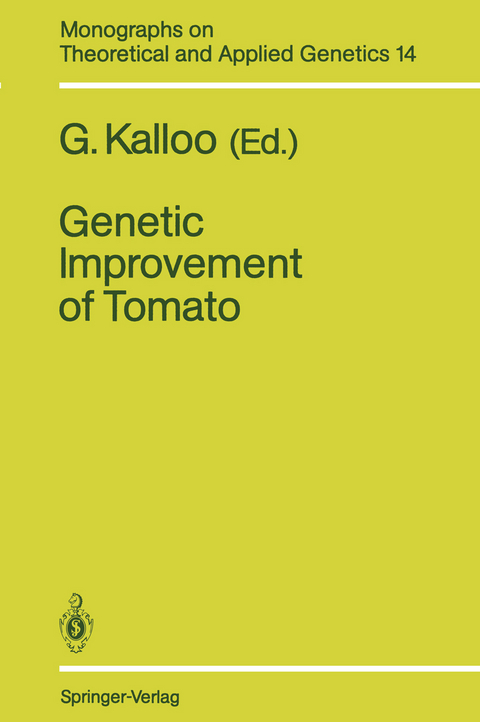
Genetic Improvement of Tomato
Springer Berlin (Verlag)
978-3-642-84277-1 (ISBN)
1 Introduction.- 1.1 Origin and History.- 1.2 Taxonomy.- 1.3 Economic Importance.- 1.4 Area and Production.- 1.5 History of Improvement.- 1.6 An Ideal Research Material.- 1.7 Seed Production.- 2 Cytology of Lycopersicon.- 2.1 Introduction.- 2.2 Mitosis.- 2.3 Meiosis.- 3 Genetics of Lycopersicon.- 3.1 Tomato as a Research Vehicle.- 3.2 Variability.- 3.3 Mutants and Genetic Stocks.- 3.4 Gene Linkage.- 3.5 Genetics of Quantitative Traits.- 4 Reproductive Biology in Tomato.- 4.1 Introduction.- 4.2 Floral Biology.- 4.3 Incompatibility.- 4.4 Artificial Hybridization.- 4.5 Genetic Male Sterility.- 5 Germplasm Resources in Lycopersicon.- 5.1 Introduction.- 5.2 Collection and Exploration.- 5.3 Evaluation and Utilization.- 5.4 Maintenance and Conservation.- 5.5 Descriptor.- 5.6 Extinction.- 6 Selection Systems for Tomato Improvement.- 6.1 Introduction.- 6.2 Improving Pedigree-Based Selection Systems.- 6.3 Population Improvement Systems.- 6.4 Selection for Combining Ability.- 6.5 Gametophytic Selection.- 6.6 Selecting Superior Parents.- 6.7 Factors Affecting Selection and Genetic Advance.- 7 Interspecific and Intergeneric Hybridization in Tomato.- 7.1 Introduction.- 7.2 Crossability.- 7.3 Hybrids and Segregating Progenies.- 7.4 Sesquidiploids.- 7.5 Barriers.- 7.6 Overcoming the Barriers.- 7.7 Transfer of Economic Attributes from Wild Species to Commercial Cultivars.- 7.8 Breeding Strategies and Limitations.- 8 Heterosis in Tomato Breeding.- 8.1 Introduction.- 8.2 Meaning of Heterosis.- 8.3 The Causes of Heterosis.- 8.4 Breeding of Ft Tomato Hybrids.- 8.5 Development of Hybrid Seed Production.- 8.6 Summary.- 9 Disease Resistance in Tomato.- 9.1 Introduction.- 9.2 Fungal Diseases.- 9.3 Bacterial Diseases.- 9.4 Virus Diseases.- 9.5 Conclusions.- 10 Insect and Mite Resistance in Tomato.- 10.1 Introduction.- 10.2 Tomato Species in Which Resistance to Insects or Mites Is Known.- 10.3 Insects and Mites to Which Resistance Is Known in Tomato Species.- 10.4 Known Mechanisms of Resistance.- 10.5 Conclusions.- 11 Root-Knot Resistance in Tomato.- 11.1 Introduction.- 11.2 Distribution.- 11.3 Pathology.- 11.4 Biology and Life History.- 11.5 Nematode Control.- 11.6 Breeding for Resistance.- 11.7 Screening for Root-Knot Resistance.- 11.8 Genetics of Resistance.- 11.9 Stability of Resistance.- 11.10 Mechanism of Resistance.- 11.11 Relationship of Root-Knot Nematodes to Other Tomato Root Diseases.- 11.12 Summary.- 12 Breeding for Environmental Stress Resistance in Tomato.- 12.1 Introduction.- 12.2 Cold Resistance.- 12.3 Heat Resistance.- 12.4 Drought Resistance.- 12.5 Excessive Moisture Resistance.- 12.6 Salt Resistance.- 12.7 Efficient Mineral Nutrition Uptake.- 12.8 Resistance to Herbicides.- 12.9 Ozone Resistance.- 13 Parthenocarpy in Tomato.- 13.1 Introduction.- 13.2 Types of Parthenocarpy.- 13.3 Sources.- 13.4 Expression.- 13.5 Genetics.- 13.6 Physiology.- 13.7 Quality of the Parthenocarpic Fruits.- 13.8 Methods of Screening for Parthenocarpy.- 13.9 Use of Parthenocarpyin Tomato Breeding.- 14 Breeding for Carotenoid Pigments in Tomato.- 14.1 Introduction.- 14.2 Regulation of Carotenogenesis.- 14.3 Function of Carotenoids.- 14.4 Characteristics of Carotenogenesis in Interspecific and Intercultivar Hybridization of Tomato.- 14.5 Express Methods for Assessing the Carotenoid Composition of Tomato Fruits.- 15 Breeding Tomato for Quality and Processing Attributes..- 15.1 Introduction.- 15.2 Fruit Quality.- 15.3 Breeding Methods.- 15.4 Testing and Evaluation of Breeding Lines.- 15.5 General Breeding Objectives.- 15.6 Specific Breeding Objectives.- 15.7 Future Prospect.- 16 Some Aspects of Breeding Tomato for Greenhouse Conditions.- 16.1 Introduction.- 16.2 Development of Cultivars and Hybrids.- 17 Breeding Tomato for Mechanized Harvesting.- 17.1 Introduction.- 17.2 Requirements of Tomato Cultivars for Mechanized Harvesting.- 17.3 Breeding for Uniform Ripening of Fruits.- 17.4 Breeding Tomatoes for Enhanced Fruit Firmness and Marketable Yield.- 17.5 TomatoBreeding for Pedicel Characteristics.- 17.6 Conclusions.- 18 Cell, Tissue and Organ Culture in Lycopersicon.- 18.1 Introduction.- 18.2 Callus and Cell Suspension Cultures.- 18.3 Root, Shoot and Plant Regeneration from Vegetative Material.- 18.4 Culture of Reproductive Organs (Anthers, Flowers, Ovaries, Embryos).- 19 Protoplast Culture and Somatic Hybridization in Lycopersicon.- 19.1 Introduction.- 19.2 Isolation and Culture of Protoplasts.- 19.3 Regeneration of Shoots and Plantlets from Isolated Protoplasts.- 19.4 Protoplast Fusion and Production of Somatic Hybrids.- 20 Genetic Variation in in-Vitro Cultures and Regenerated Plants in Tomato and Its Implications.- 20.1 Introduction.- 20.2 In Vitro Differentiation and Nuclear Processes.- 20.3 Phenotypic and Genetic Variation in Regenerated Plants.- 20.4 Variants or Mutants from Cell and Callus Cultures.- 20.5 Factors Influencing Variation.- 20.6 Conclusions.- 21 Isozymes in Lycopersicon.- 21.1 Introduction.- 21.2 Variations in Lycopersicon species.- 21.3 Applications in Breeding Practices.- 22 Genetic Transformation of Tomato and Prospects for Gene Transfer.- 22.1 Introduction.- 22.2 The Ti-Plasmid as Natural Gene Vector.- 22.3 Agrobacterium-Medizted Plant Cell Transformation.- 22.4 Direct Gene Transfer.- 22.5 Application of Genetic Transformation in Lycopersicon.- 22.6 Concluding Remarks.- References.
| Erscheint lt. Verlag | 27.12.2011 |
|---|---|
| Reihe/Serie | Monographs on Theoretical and Applied Genetics |
| Zusatzinfo | XIII, 358 p. 14 illus. |
| Verlagsort | Berlin |
| Sprache | englisch |
| Maße | 155 x 235 mm |
| Gewicht | 568 g |
| Themenwelt | Naturwissenschaften ► Biologie ► Mikrobiologie / Immunologie |
| Naturwissenschaften ► Biologie ► Zellbiologie | |
| Schlagworte | Biology • Biotechnology • cytology • Genetics • Harvesting • Meiosis • molecular genetics • Mutagenesis • Pflanzenzüchtung • Plant • Plant Breeding • plants • resistance • Tomate • Züchtungsgenetik |
| ISBN-10 | 3-642-84277-1 / 3642842771 |
| ISBN-13 | 978-3-642-84277-1 / 9783642842771 |
| Zustand | Neuware |
| Haben Sie eine Frage zum Produkt? |
aus dem Bereich


